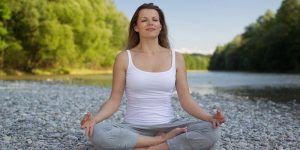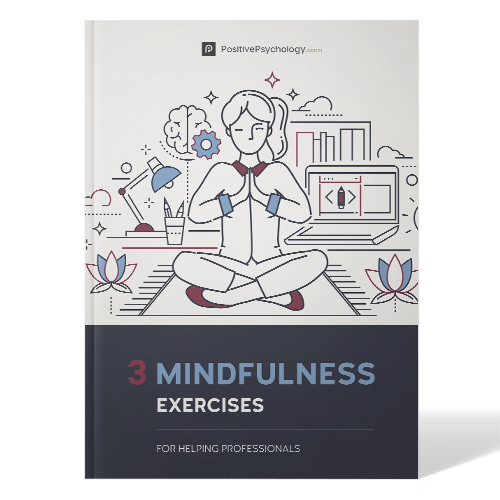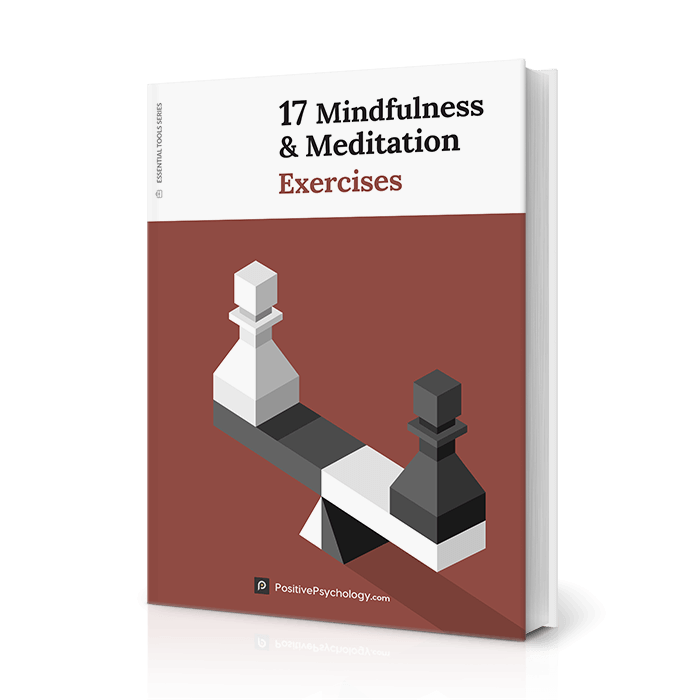30 Meditation Exercises and Activities to Practice Today
 Many studies have proven that meditation has numerous physiological benefits, including a study done at Harvard University.
Many studies have proven that meditation has numerous physiological benefits, including a study done at Harvard University.
In the 8-week study, researchers determined that a simple practice like meditation could rebuild the grey matter of the brain in as little as eight weeks.
The brain’s gray matter is responsible for the primary thinking, perceiving, and cognitive functions of the brain, helping us process information.
Meditation can do much more than boosting the brain, and it may even help you reduce your blood pressure, fight anxiety, and help you fight pain.
In this article, we will look at some of the many activities and exercises you can do so you can take advantage of this wonderful state of mind.
Before you read on, we thought you might like to download our three Mindfulness Exercises for free. These science-based, comprehensive exercises will not only help you cultivate a sense of inner peace throughout your daily life but will also give you the tools to enhance the mindfulness of your clients, students, or employees.
This Article Contains:
- What are Meditation Exercises and Activities?
- 3 Meditation Breathing Exercises
- 3 Exercises to Help with Anxiety and Stress
- 2 Meditation Exercises for Better Sleep
- Running Groups and Workshops
- Meditation to Improve Concentration
- 2 Easy Meditation Exercises for Beginners
- Working With Seniors and Adults
- 3 Classroom Meditation Activities for Students
- 2 Quick and Fun Meditation Activities
- 2 Mindfulness Meditation Exercises
- Transcendental Meditation Exercises
- Stoic Meditation Exercises
- 3 Visualization Meditation Exercises
- 3 Useful Meditation Worksheets (PDF)
- 3 Guided Meditation Exercises on Youtube
- A Take-Home Message
- References
What are Meditation Exercises and Activities?
There are many types of meditation practices and activities you can do on your own. There are also activities you can do as part of a group.
A meditation exercise can be as simple as doing some deep breathing, or as complex as repeating a mantra or doing Transcendental meditation. Any activity that helps to quiet the mind could be considered a meditative activity, even sitting outside and quietly watching the world go by.
There are many types of meditations, including but not limited to:
- Deep breathing exercises
- Relaxation exercises
- Guided Imagery and Visualization
- Focused Attention Meditation
- Loving-kindness Meditation
- Progressive Relaxation Meditation
- Body Scan Meditation
- Mindfulness Meditation
- Awareness of the Breath Meditation
- Transcendental Meditation
- Zen Meditation
- Yoga Meditation
3 Meditation Breathing Exercises

- The Stimulating Breath or Bellow Breath.
- Relaxing Breathing Exercise (4-7-8 Breathing).
- Counting the Breath.
According to Dr. Weil (2019), practicing regular mindful breathing can help you feel calm and energized, and it may even help you manage stress-related health problems.
Breathing is something we can regulate and control, and it is an excellent tool for helping to clear the mind and achieve a state of relaxation.
These simple breathing techniques can help you relax and help you reduce stress.
1. The stimulating breath (Bellows breath)
The stimulating breath or bellows breath is a great way to boost your energy. This type of breathing practice is often done in yoga to help increase Prana, or life force energy.
The stimulating breath can help you increase your energy and help you be more alert. The bellows breath is a safe practice, but it could make you dizzy initially until your body gets used to the increased energy.
Strive for no more than 15 seconds or so on your first try, working up to a minute. Each time you practice this breath, you can increase your time little by little.
- Sit up tall with your back straight and relax your shoulders.
- Begin inhaling and exhaling rapidly through your nose. Keep your mouth closed but relaxed. The in and out breaths should be equal in duration, but as short and quick as possible. The bellows breath is a noisy breathing exercise.
- Try for three complete breath cycles per second. As you breathe, you will notice a quick movement of the diaphragm, like a bellows.
This technique should leave you feeling invigorated and alert.
2. Relaxing breathing (4-7-8) exercise
The 4-7-8 breathing exercise is a straightforward technique, as well. It involves breathing in while counting to four, holding the breath to the count of seven, and exhaling to the count of eight.
This technique is a natural tranquilizer for the nervous system. However, you should not do more than four breaths at one time initially because it may leave you feeling lightheaded.
- Sit with a straight back and relax your shoulders.
- Place your tongue tip against the tissue behind your upper front teeth and try and keep your tongue in place as you breathe.
- Inhale through your nose to a count of four.
- Hold your breath for seven seconds.
- Exhale through your mouth for approximately eight seconds.
This is considered one cycle of breath. You may repeat this three or four more times.
The most important thing about this exercise is the 4-7-8 ratio. If you have trouble holding your breath for seven seconds, you can speed the practice up.
Once you learn this technique, you can use it to combat stress when you feel it coming on.
3. Counting the breath
Counting the breath is another good exercise.
- Sit in a comfortable position with your back straight. Qclose your eyes and take a few deep breaths in and out breathe naturally.
- Now, as you inhale, mentally count to one and slowly exhale.
- Inhale again, counting to two, and slowly exhale.
- Repeat this cycle as long as you feel like doing it, counting as you go.
Strive for a ten-minute breathing practice.
3 Exercises to Help with Anxiety and Stress
Researchers at John Hopkins University in Baltimore, MD, reviewed nearly 19,000 meditation studies. The research showed that mindfulness meditation could help ease psychological stresses like anxiety, depression, and even pain. (Goyal, 2014).
1. The Body Scan Meditation
The body scan meditation, or body awareness, is an exercise that allows you to tune out distractions while focusing on various areas of the body.
Body Scanning is a great technique that helps you become more aware of how you are feeling in any given moment.
Excess muscle tension exacerbates muscle pain, headaches, and fatigue, and scanning the body can help you prevent the build-up of pressure.
You can either do a quick body scan or a more extended scan. A quick scan can help you immediately release tension, and it only takes a few seconds.
- Get into a comfortable position. You can sit or lie down.
- Close your eyes for a deeper practice.
- Starting with your feet and toes, tune into and pay attention to any sensations you feel, like pain or discomfort. You may also notice sensations like tingling, stinging, aching or throbbing.
- Take a nice deep breath in through your nose, exhaling through the mouth, releasing the uncomfortable sensation. Allow that area of your body to release, loosen up, and soften.
- Work your way up the body, paying attention to how you feel as you focus on the legs, the hips, the back, the stomach, the chest, the neck and shoulders, the arms and hands, and finally the face.
- Move progressively up your body, focusing on each muscle group one at a time.
2. Diaphragmatic breathing
Diaphragmatic breathing or abdominal breathing is another good way to ease stress and anxiety. Breathing in this manner produces the relaxation response in the body, which allows the respiratory system to function correctly.
Breathing shallow can often contribute to feelings of anxiety, panic, or stress. Practicing abdominal breathing allows the mind and body to slow down and relax.
- Lie on your back on a supportive surface. Bend your knees and support your head with a pillow. You may also place a pillow under your knees.
- Place one hand on your chest and the other below your rib cage. Breathe in deeply through your nose so you can feel the hand on your stomach gently rising.
- Allow the muscles of your stomach to tense and tighten as you exhale through your lips.
- Practice this breathing technique for about 5-10 minutes 3-4 times a day if possible. This type of deep breathing is excellent for stress, and it helps calm and relaxes you.
Read more here about breathing exercises.
3. Progressive muscle relaxation
Progressive muscle relaxation is a simple exercise where you tense and release all the muscles in your body, working your way up from the feet and toes to the head.
The exercise is designed to help the body progressively relax, just like the name sounds. This technique can help decrease muscle tension, fatigue, neck and back pain, or even muscle spasms.
This technique also reduces the physiological tension caused by thoughts that tend to provoke anxiety.
In this exercise, you should strive to tense and then relax all of those large muscles in the body. This should be done systematically either working your way down from the head or up from the feet and toes.
Deep muscle relaxation helps reduce physiological tension as well.
- Get into a comfortable position, either sitting or lying down.
- Strive to tense and then release each large muscle or muscle group for about five seconds or so, then relax the muscles.
- Begin by taking a few deep breaths from the abdomen. Tense, hold, and relax each large muscle group, working your way up or down the body.
- Try and notice the contrast between a tensed state and a relaxed state inhaling as you tense the muscle and exhaling as you relax and let go.
- Once you have mastered this technique, you can then do a quick version in which whole muscle groups are tensed and relaxed simultaneously.
2 Meditation Exercises for Better Sleep
Good sleep. Need we say more? A vital aspect of good health, try these meditation exercises prior to going to bed, to improve your sleep habits.
1. Visualization

Anytime you use your imagination, you are in essence, daydreaming and visualizing.
Visualization for relaxation and sleep utilizes the imagination to create a mental location where the mind can be calm, and the body can be relaxed.
Visualization helps relax the mind and body, clearing away the clutter of the day. As you visualize, you can practice seeing things with all of your senses.
Visualization, also called Guided Imagery is a wonderful way to take a mini-vacation in your mind.
- Start by closing your eyes and imagining in your mind a peaceful and relaxing place like a beach or a park.
- Allow your imagination to feel and see everything, using all of your senses. Feel the warm sun, hear the ocean, or watch the birds.
- If stressful thoughts enter your mind, acknowledge them, and dismiss them.
2. The blackboard technique
Counting is another good way to help you fall asleep. The blackboard technique involves writing numbers down on a chalkboard and then erasing them in your mind.
You can also imagine a black curtain and watch the numbers appear and disappear. The act of having to keep track of numbers makes you sleepy because you will get bored trying to do so.
- Start by closing your eyes and picturing a huge blackboard. The blackboard can be as big as you are.
- Now in your imagination, take the chalk and write down the number 100 on the board as large as you can write it.
- Then erase the number away as slowly as you can, making sure that all of the chalk is removed from the blackboard.
- Write the number 99 next, then erasing it very slowly.
- Continue counting down until you fall asleep or reach zero when the task begins again.
You may be surprised at how quickly you lose track of the numbers and drift off to sleep.
Running Groups and Workshops
According to Tara Brach, Ph.D., psychologist, author, and teacher of meditation, a mindfulness meditation group is a wonderful way to connect with others and deepen your meditation practice (Brach, n.d.).
There are no rules and groups come in many shapes and sizes. Hosting a group is a great way to hold yourself accountable and provide a support system and a space to connect with others.
Getting together with like-minded people can help you strengthen your meditation practice.
Meditation groups typically start with a handful of interested friends meeting somewhere to practice.
As the group grows, you might end up meeting in a larger space like a hall or a church. You can even have online groups for those who have limited access or for those who can’t leave their home.
A group can be two people or ten people. Some people enjoy a small group, while others may be more comfortable in a larger setting.
You can start with a simple meditation like a deep breathing practice and work your way up to more complex meditations, like guided imagery.
Groups also offer a wonderful way to share experiences. For example, you can practice going around the room and talking about each person’s experience in terms of their meditation practice and what they enjoy or what they may be struggling with.
This kind of mindful sharing is a great opportunity to learn from others.
If you’re hosting a workshop, you will probably want to create some formal outline of topics to cover in the event.
If you feel uncomfortable hosting an event on your own, consider getting a co-host to help you prepare and run the event.
Meditation to Improve Concentration

Focused meditation is a technique where you choose to focus on something like an object with solitary intent. You would focus on this object to the exclusion of all other things (Bertone, 2020).
For example, you can focus on a flower, a small stone, or anything you find lying around like a candle or a decorative object. You can also focus on the object with your eyes open, and then close your eyes and try and imagine the object in every little detail.
In this exercise, you would practice focusing with attention without trying too hard. By choosing to focus on one thing only, like a small object, you begin to quiet your busy mind and feel that sense of peace in the spaces between the thoughts.
The focused meditation technique is a very calming and centering practice because it anchors you in the present moment, freeing you from judgments about the past or worrying about the future.
- Find an object to focus on. If you would like to hold an object to start with, you may do that now.
- Begin by closing your eyes and focusing your attention on your breath, breathing slowly and deeply.
- Now begin to focus on your object. If you are holding something, open your eyes for a brief moment and study the object, looking at all those little details. Gently close your eyes once again.
- If you are picturing an object, start thinking about the item and focus your attention on what you recall about the object. If you are inside, you can also focus in on whatever is nearby like a lamp, a candle, or a small object.
- Imagine this object in every little detail. If you are outside, focus on something in your immediate environment.
- As you close your eyes, try and recall every little detail of this object in your mind’s eye, and see how powerful your perceptions are. Recall all of the tiny little details down to each crease and each small little bump. Focus all of your attention on this process and see what you recall.
The more you practice this type of focused meditation, the easier it will be to recall all of those little details, helping you sharpen your focus.
2 Easy Meditation Exercises for Beginners
Everyone is a beginner at one point. If you are only starting meditating, don’t feel that you have to catch up with everyone else. Instead, make use of the following beginner meditation exercises and set your own pace.
1. Walking meditation
Nothing is simpler than a walking meditation. A walking meditation is a great choice for those who like the outdoors or for those who have trouble sitting still and clearing their mind.
In walking meditation, you walk silently and contemplatively. Walking is very calming for the mind, body, and spirit (Hanh, 2011). If you find yourself stressed, one of the best things you can do is to get outside and move and take a break. Taking a short walk, or even a long walk is simple to do, and it can help ease away stress and anxiety.
For those who have trouble sitting still, a walking meditation is a wonderful option. Incorporating a simple walking meditation into your day is a wonderful way to ease away the tension of the day. The goal of walking meditation is to become mindful of the present moment (Hanh, 2011). You can do a walking meditation anywhere, but an ideal place is a park or somewhere that has greenery or foliage.
This Walking Meditation is based on the guided walking meditation from Jon Kabat-Zinn, a mindfulness expert.
- Start by finding a suitable location, a peaceful place where you won’t be disturbed or observed.
- Walk 10-15 steps and then pause and breathe for as long as you like.
- Observe the environment around you. Stop and contemplate the trees, the foliage, the flowers, and even the ground you are standing on. Notice all the little details.
- You can also observe as you walk. The idea behind the practice is to walk silently and with a sense of deep contemplation.
- You can also focus on the sound of your footsteps as you walk and notice how your feet hit the ground.
A walking meditation involves very deliberate thinking and doing a series of actions that you usually do automatically.
As you walk, try to focus your attention on one or more sensations that you would typically take for granted, such as your breathing, the way your legs move or how the air feels against your skin.
If your mind wanders, continue focusing on something specific in your environment.
Our Toolkit also includes a downloadable PDF and MP3 Mindful Walking tool, which you can access with a subscription to the 400+ tools included in the Positive Psychology Toolkit©.
2. Gratitude meditation
A Gratitude Meditation is a practice where you reflect on all the gifts in your life. It’s a simple practice with significant results.
This meditation offered by Dr. Kathi Kemper at the Ohio State University’s Center for Integrative Health and Wellness is a great place to start.
The practice of focusing on things you feel grateful for can help you shift your focus away from the negative and onto the positive.
As you experience positive emotions like gratitude, loving-kindness, and compassion, your awareness broadens, and your creativity and problem-solving capacities expand.
A short version of this meditation could be done by closing your eyes, taking a deep breath and mentally listing 5-7 things you feel grateful for like a warm home, a soft blanket, a loving spouse, a caring friend or even a good job or financial security.
Working With Seniors and Adults

One simple practice that can be done with seniors would be the Mindful Listening Practice.
Mindful listening involves closing your eyes and taking the time to be still and to listen to what is going on around you. The stream of sounds that occur in our environment can even be compared to the flow of thoughts in our mind.
This kind of simple practice can help improve communication skills and help the listener to be more present throughout the day.
3 Classroom Meditation Activities for Students
Below you will find a few mindfulness meditation activities that can be easily taught to students.
1. Stillness challenge
Using a timer and calming music is a great way to teach children the basic premise behind meditation and mindfulness.
Students are asked to sit still and listen to the soothing music without moving. You can also dim the lights and perhaps set a timer for 3-5 minutes.
Ask students to find a cozy spot and to sit comfortably and tell them that together you are going to start a new stillness challenge.
The object of the challenge is to sit with your eyes closed without moving or fidgeting as much as possible.
Once the timer goes off, they can then open their eyes and stretch. You can also start with 1 minute and work up to more extended time frames.
2. Breathing buddy meditation
The breathing buddy meditation involves holding a stuffed animal. Students begin by choosing a stuffed animal like a teddy bear and then lying down and closing their eyes.
Next, you set a timer for 3-5 minutes and ask the students to place the stuffed animal on their belly as they rest.
If the object falls off, they can put it back and keep breathing. The objective is to keep the focus on the breath and to balance the object for as long as they can do so.
3. Sound focus meditation
The sound focus meditation involves listening to some bell or tone, like a Tibetan singing bowl.
Students are asked to sit comfortably with their eyes closed. As students listen to the bell or the tone, they are asked to breathe quietly and listen intently, especially as the sound fades away.
This exercise is a good way to help students learn to focus and concentrate.
2 Quick and Fun Meditation Activities
Quick techniques you can apply during the day.
Exercise One – One Minute of Mindfulness

This exercise can also be done throughout the day. Set a timer for 60 seconds and use the minute to focus solely on your breathing. Notice how your breath sounds as you breathe in and out and notice how your body feels. If your mind starts wandering, bring your attention back to your breathing.
This may seem like a simple exercise, but it can be a very powerful one. You can do this exercise with your eyes opened or closed.
Exercise Two – Conscious Observation
This is another quick technique that can help you clear your mind. Pick up an object you have lying around. Any object will do. Hold the object in your hands and allow your attention to be fully absorbed by the object. If you are holding a coffee mug, notice how it feels in your hands. Don’t over-analyze it either, allow yourself to be present in the moment.
This type of conscious observation is a powerful form of meditation.
2 Mindfulness Meditation Exercises
There are many mindfulness exercises you can practice. A simple breathing exercise is a good place to start.
Two-minute breathing exercise
Begin by getting into a comfortable position. Set a timer for 2 minutes. Close your eyes so you won’t be distracted. Relax and see if you notice any areas that seem tight or stiff. If you do, try breathing in and softening those areas.
Check-in with your body and notice how your back feels against the chair or how your feet feel touching the floor. Notice the gentle pull of gravity.
Breathe in through your nose and exhale through your mouth. Notice how the breath effortlessly flows. Notice your belly rising and falling.
Pay attention to how this quick meditation makes you feel as you open your eyes.
Gratitude meditation
Taking a moment to stop and practice gratitude is very powerful. A study done in 2015 showed that mindfulness-based gratitude practices were associated with improvements in happiness, resulting in less stress (O’Leary & Dockray, 2015).
Close your eyes and reflect on something small that you notice at the moment. This might be something like the sight of a tree outside or a feeling of warmth.
Next, reflect on someone who has had an impact on your life. This might be someone you know personally or someone you don’t know.
Express some gratitude for all those things you are grateful for, like a hot cup of coffee in the morning or a good friend.
And don’t forget to express some gratitude for your healthy body and for having the presence of mind to be here in this moment.
Take as much time as you need to meditate and reflect.
Transcendental Meditation Exercises
Transcendental Meditation (TM) is a meditation technique that is designed to help you increase your awareness, and it can also help you avoid thoughts that may be distracting.
The technique is from the ancient Vedic traditions of India.
TM uses the idea of repeating a mantra, which is given to the person by the TM instructor. The technique involves closing your eyes and getting into a comfortable position and repeating your word or phrase.
Doing so can help you sharpen your focus and transcend the normal ordinary process of thinking.
Stoic Meditation Exercises
Stoic meditation is based on Stoicism, a philosophy based on restraint, compassion, and humility.
The Negative Visualization exercise can help you increase your level of happiness as you focus on how you would feel if you lost certain things from your life (Irvine, 2008).
This exercise, while it sounds negative, can help you gain a new level of appreciation for the things you have. Try closing your eyes and imagining how you would feel if you didn’t have a roof over your head or if you lived in a third world country.
Imagine losing a loved one, an arm, or losing your social status or your job. This exercise is an excellent way to practice gratitude because it allows you to see how blessed you truly are in any given moment.
3 Visualization Meditation Exercises

Visualization also involves using your imagination, much as you did as a child.
With visualization meditation, close your eyes and imagine yourself somewhere that makes you happy.
Exercise Number 1 – The Beach
Begin by closing your eyes and taking some long, slow deep breaths. Take at least 3-4 breaths. Now imagine yourself walking on the beach. Try and use all of your senses and see, feel, and hear things. Feel the sun on your skin, and listen for the sound of the waves. Imagine the brilliant blue water and how nice and white the sand is.
As you walk, you might even pick up some small shells or enjoy the feel of the ocean water on your feet. Taste the saltwater on your tongue and enjoy the experience. Stay here as long as you like, and immerse yourself in the experience.
Exercise Number 2 – The Blank Screen
The blank screen helps you empty your mind. Imagine you are staring at a white wall or blank screen. Whenever you notice a random thought, see yourself erasing the thought out of your mind.
When you allow your mind to go blank, you offer no resistance, so your vibration rises naturally. You can then work on any goal you like.
Exercise Number 3 – Forest Trail
This is a great exercise to do for stress relief. Imagine yourself walking on a trail in the forest. Hear the sticks and twigs crackling under your feet as you walk and smell the mustiness of the environment.
As you walk, notice how good you feel. Feel the sun on your skin and smell the flowers and plants. You could even stop and sit on a log and see what else you notice. Take as much time as you need to rest and relax. For a bonus, see if you can picture yourself sitting in front of a beautiful, serene lake.
The more you visualize, the easier it gets. Try some visualization work the next time you have an important goal to work on, and you might be surprised at how well it works!
3 Useful Meditation Worksheets (PDF)
There are some wonderful meditation worksheets that can act as a guide to help you throughout your day. A few of these include:
Meditation Worksheet #1 – How to Quiet Your Mind in the Midst of Chaos
Step One: Focus on the Breath
Notice your state of being by focusing on your breath. What can your breath tell you about how you are feeling? For example, you might be feeling calm, grounded, energized or even agitated. Write down how you are feeling as you focus on your breath.
Step Two: Develop a Sense of Gratitude
List some things you feel grateful for in this moment. You can be grateful for many things including your health, friendships, financial security, relationships, abundance, etc. What do you feel grateful for?
Step Three: Set an Intention
The next step involves setting an intention for the day. This might include setting the intention to be present, to feel grounded or to remain calm during a challenging situation. List an intention or intentions for the day.
Step Four: Let Go
Ask yourself what you are holding onto that no longer serves you? List some worries or some things you can let go off. For example, you can let go of the need to be liked, the need to be perfect or let go of the constant tendency to worry. What can you let go of?
This worksheet is similar to the meditation worksheet you can download at Quartner & Associates.
Meditation Worksheet #2 – STOP Technique
The STOP technique was developed by Elisha Goldstein. It is designed to help you manage your worried mind by helping you create some mental space.
As you tune into the present moment you can help mitigate the negative effects of the stress response. When you drop into the present moment, you are more likely to gain perspective and see that you have the power to regulate your response to pressure.
This technique is wonderful to practice anytime you feel anxious or worried.
S = Stop
Stop what you’re doing and put things down for a moment.
T = Take
Take 2-3 nice deep breaths. Strive to breathe all the way down into the lower belly.
O = Observe
Observe how you are feeling. Note what thoughts, feelings or emotions are running through your mind. Realize that thoughts are not permanent – they come and they go.
Research shows that the simple act of naming your emotions can turn the volume down on the fear circuits in the brain resulting in a feeling of calm. Notice your body and how you are standing or sitting. Notice your posture or if you have any aches and pains.
P = Proceed
Proceed with something that can support you in the moment. Call a friend, take a walk, have a cup of coffee or tea.
Try this the next time you feel anxious. Notice how stopping and tuning into how you are feeling can change your perspective. What would it be like in the days, weeks, and months ahead if you started stopping more often?
This worksheet is similar to the exercise found on mindful.
Meditation Worksheet #3 – Letting Go of Your Story
The stories that we continually tell ourselves about our lives can be very limiting and inaccurate.
Learning how to identify your story can set you free. It can also help you create a new story.
As you go through this exercise, reflect upon the story or stories you believe about your life. Question their validity, and practice letting them go.
Creating a New Story
- Find a quiet place and a time where you won’t be disturbed and somewhere you have time to reflect.
- Start by asking yourself what stories you believe about yourself and how they might be holding you back from being happy, successful, etc.
- Ask yourself what you truly want.
- Think about how you introduce yourself to people or what you tell people.
- Once you have identified your story (or one of them), notice how your body feels when you believe this story.
- Pay attention to what thoughts arise when you believe this story.
- Next, ask yourself who created this story and if it is even accurate.
- Begin to imagine what it would feel like if you didn’t actually believe this story, and see how it feels to let go of it, for even a moment.
- Observe how you feel as you let this story go.
- Ask yourself what you would do differently if you didn’t believe this story.
- As you go throughout the day, ask yourself what story you are holding onto that might still be holding you back.
- And remember to be patient when letting go of your story. Practice self-compassion. You don’t have to let your entire story go all at once.
This worksheet is similar to the worksheet available at Mindfulness Exercises.
3 Guided Meditation Exercises on YouTube
There are hundreds if not thousands of guided meditations available for free on YouTube.
Michael Sealey’s Guided Meditation for Detachment from Over-Thinking is a great place to start because it can help you release anxiety and stress. This meditation encourages a calm awareness of the breath and a detachment from everyday thoughts.
Jason Stephenson’s Guided Meditation for Anxiety and Stress is another good choice. This is a beginner meditation using visualization and guided imagery.
The Breathing Meditation from the UCLA Mindful Awareness Research Center gently guides you through a simple breathing practice to help you focus your awareness.
A Take-Home Message
As you can see, there are hundreds of tools and methods to start a simple meditation practice. Meditation doesn’t have to be complicated, and it can be as simple as doing some deep breathing or taking a mindful walk.
The best place to start is to make that commitment to take some time out of your day to center your thoughts and focus your awareness.
The more you practice these simple techniques, the better you will feel about your meditation practice.
We hope you enjoyed reading this article. Don’t forget to download our three Mindfulness Exercises for free.
- Bertone, H. (2020). Which type of meditation is right for me? Healthline. https://www.healthline.com/health/mental-health/types-of-meditation
- Brach, T. (n.d.). How to start a mindfulness meditation group. Tara Brach. Retrieved from https://www.tarabrach.com/starting-meditation-group/
- Goyal, M., Singh, S., Sibinga, E. M., Gould, N. F., Rowland-Seymour, A., Sharma, R., … & Haythornthwaite, J. A. (2014). Meditation programs for psychological stress and well-being: a systematic review and meta-analysis. JAMA Internal Medicine, 174(3), 357-368.
- Hanh, T. N. (2011). The long road turns to joy: A guide to walking meditation. Berkeley, CA: Parallax Press.
- Irvine, W. B. (2008). A guide to the good life: The ancient art of Stoic joy. New York, NY: Oxford University Press.
- O’Leary, K., & Dockray, S. (2015). The effects of two novel gratitude and mindfulness interventions on well-being. The Journal of Alternative and Complementary Medicine, 21(4), 243-245.
- Raypoole, C. (2020, May 28). 5 Visualization techniques to add to your meditation practice. Healthline. Retrieved from https://www.healthline.com/health/visualization-meditation
- Weil, A. (2019, July 1). Three breathing exercises and techniques. Retrieved from https://www.drweil.com/health-wellness/body-mind-spirit/stress-anxiety/breathing-three-exercises/
Let us know your thoughts
Read other articles by their category
- Body & Brain (49)
- Coaching & Application (57)
- Compassion (26)
- Counseling (51)
- Emotional Intelligence (24)
- Gratitude (18)
- Grief & Bereavement (21)
- Happiness & SWB (40)
- Meaning & Values (26)
- Meditation (20)
- Mindfulness (45)
- Motivation & Goals (45)
- Optimism & Mindset (34)
- Positive CBT (28)
- Positive Communication (20)
- Positive Education (47)
- Positive Emotions (32)
- Positive Leadership (18)
- Positive Parenting (4)
- Positive Psychology (33)
- Positive Workplace (37)
- Productivity (16)
- Relationships (46)
- Resilience & Coping (36)
- Self Awareness (21)
- Self Esteem (38)
- Strengths & Virtues (31)
- Stress & Burnout Prevention (34)
- Theory & Books (46)
- Therapy Exercises (37)
- Types of Therapy (64)





What our readers think
Saved to my daily morning reading list – after I blocked all the images to save space on my storage drive.
Why oh why would positivepsychologytoday NOT offer a “clean”, minimal version of such pages for people to save. Many of us simply cannot afford the luxury of professional help, or even frivolous waste of our computer reources.
I hope the Editors will take this constructive critique into consideration.
Great information, Thanks.
Jyothi. Ravichandran, thank you very much for your comment. I had never thought about the implications of the term “third world country” in this way. However, I do know that the many in the western world can be ignorant about the lives of people in other countries than their own. I will not be using that term again. Elizabeth Barnes
A lovely, inspiring article. I could read it again and again.
A lovely, inspiring article. I could read it again and again.
As much as I appreciate the exercises, some sensitivity can be paid to underlying biases. It’s not the worst thing to live in a “third world country” which is a term that is outdated and offensive. Teaching mindfulness by looking down at things/situations different from what one occupies does not count as gratitude. It is infact reinforcing of discriminatory thought. I live in a “third world country” that gave mindfulness to the world. Enjoy the practices!
Lots of strategies to try and practice on. Great resource!
useful for any one. Especially busy people.